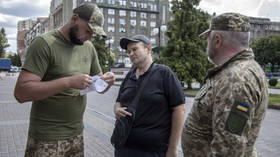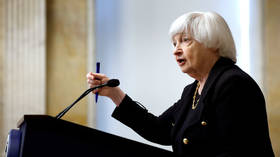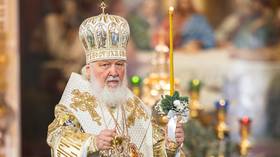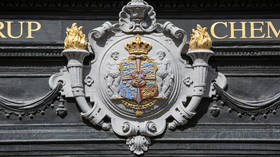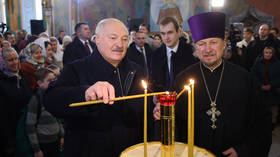Rewriting history: ‘Flags of Our Fathers’ author admits his dad isn’t in iconic Iwo Jima photo

The Marine Corps has announced an investigation into the identity of one of the men in the iconic Iwo Jima photograph, after amateur historians questioned the image and revealed a 70-year-old case of mistaken identity.
James Bradley, who wrote a book about the event and believed his father was one of the men, now says he thinks his father is not in the picture, Stars & Stripes reports.
Photographer Joe Rosenthal was awarded a Pulitzer Prize on May 7th 1945 for his picture of the Iwo Jima flag-raising pic.twitter.com/nw4YK6jGsB
— Histi Pics (@HistiPics) May 3, 2016
The iconic photograph was taken by AP photographer Joe Rosenthal in February 1945, during the 36-day battle for the island in Japan. Rosenthal captured the second flag-raising of the day, after missing the first which took place earlier.
Five US Marines and one Navy sailor are seen raising the US flag on Mount Suribachi, on the island of Iwo Jima.
The men in the photo were identified as John Bradley, Rene Gagnon, Ira Hayes, Harlon Block, Michael Strank, and Franklin Sousley.
The controversial photograph served as a propaganda tool for the US, sending the message that it was winning the war.
When the photograph was first published, the surviving men - John Bradley, Rene Gagnon, and Ira Hayes - were sent back to the States on a promotional tour to drum up war bonds. The image later became a symbol of victory and the Marines had it made into a statue at Arlington.
Iwo Jima Memorial located in Arlington, VA pic.twitter.com/F8pu9474vq
— USA Bravery (@USABravery) March 5, 2016
Bradley’s book, Flags of our Fathers told the story of the battle and was made into a Clint Eastwood movie in 2006.
In 2010, the Marines released new photographs which showed his father was involved in the first flag raising. Bradley later edited the book to say his father was at both flag raisings, but amateur historians Stephen Foley from Ireland and Eric Krelle from Omaha discovered this was not the case.
Their findings were first published in the Omaha World Herald by Matthew Hansen in 2014, who described the find as “something that has apparently eluded military leaders, World War II experts, and historians for nearly seven decades.”
The man thought to be Bradley, who stands in the center of the image, is in fact Franklin Sousley, who was originally identified as being to Bradley’s left. The man who was thought to be Sousley is a previously unknown Marine named Harold Schultz, Hansen reports.
Foley first made the discovery in 2013 when he saw other photographs from that day and realized Bradley didn’t look like the man in the iconic image.
#photography photosandbacon: US Soldier supplies, Iwo Jima, 1945 https://t.co/jNjSWZ8S09pic.twitter.com/Doljj8JyHv
— PHOTO graphia (@go_watchme) January 10, 2016
As he was recovering from surgery, he had time to study all of the available photographs online and discovered a number of differences in the uniform worn by the man in the flag-raising photograph as compared to other photographs of him.
Foley contacted Eric Krelle, who ran a website about the Marines. He was convinced by Foley’s research and began to search for the identity of the mystery man. His large collection of Marines memorabilia contained film footage of the raising, which he watched frame by frame. He was eventually able to identify the man as Schultz.
The two then reached out to historians, who weren’t interested in their discovery, but after Krelle contacted Hanson, the story was published in 2014.
When Hansen contacted Bradley’s son with the news, he was skeptical.
"So, you are telling me that there are all these witnesses, these survivors who come home, and nobody says anything, and then someone figures out it's different 70 years later, when they are all gone? I mean, come on," he said. Bradley refused to look at the research which was sent to him.
"Listen, I wrote a book based on facts told to me by guys who had actually been there. That's my research. That's what I trust," he told the reporter.
James Bradley, son of John Bradley & author of bestselling book "Flags of Our Fathers" now says his dad wasn't in famous flag raising photo.
— Matthew Hansen (@redcloud_scribe) May 3, 2016
In an interview with the New York Times published on Tuesday, Bradley said he changed his mind last year after deciding to read the article Hansen had sent him in 2014.
However, Hansen reports Bradley told AP he was “shocked” the day before.
“This is unbelievable. I am interested in facts and truths, so that’s fine, but I don’t know what’s happening,” he said.
The Smithsonian has carried out months of research into the claims and is now working with the Marines as they review the information.
Marine Corps Statement on Iwo Jima Photo Review: pic.twitter.com/49ZO8jr9wV
— U.S. Marines (@USMC) May 4, 2016
The jarheads released a statement Monday: “The Marine Corps is examining information provided by a private organization related to Joe Rosenthal’s Associated Press photograph of the second flag raising on Iwo Jima.”
The photograph was long dismissed as staged, as it depicts the raising of the second, larger flag that was taken from a ship and raised to replace the first flag later that day.
Marine photographer Louis Lowery had taken a number of images of the first flag raising, but they never received the same attention. Rosenthal captured the now-iconic photograph of the second flag when he reached the mountaintop.
@KySportsRadio@ryanlemond This is the 1st flag-raising photo on Mt. Suribachi, taken by SSgt Louis R. Lowery, USMC pic.twitter.com/8QZX5uI7DO
— Steve Moody (@kyracer57) May 4, 2016
Hansen reflected on the discovery this week. “Only outsiders were willing to challenge that unchallengeable truth. Only they were willing to risk veering dangerously close to tinfoil hat territory,” Hanson wrote. “And because they did that, we have somehow gone from an Irishman on his couch, and an Omahan on his home computer late at night, to a Marine Corps investigation, a Smithsonian documentary, and the ‘Flags Of Our Fathers’ writer publicly doubting a foundational fact underlying his book.”
The Battle of Iwo Jima took place off the coast of Tokyo when 70,000 Marines and 18,000 soldiers fought in a bloody showdown which claimed the lives of more than 6,000 Americans and up to 18,000 Japanese.


